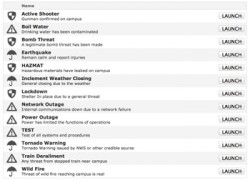Omnilert, LLC today announced the release of the tool that allows multiple emergency communication actions to sequentially deploy with predefined scenarios, making emergency response quicker, easier and more effective. With Scenarios, client administrators can build multiple unique actions including initiating an outbound conference call, sending different messages to different groups with different endpoints, or even requesting status or feedback. A dispatcher of alerts can later deploy all of this with one click. This new breakthrough capability is available to all Omnilert clients Monday, April 15. Live demonstrations are available in e2Campus booth #1143 at the National School Boards Association Conference and booth #503 at the ACUTA Annual Conference, both in San Diego through April 17.
“In an emergency, time is critical and Scenarios makes it easy to respond quickly, without the emotion of a crisis because you are able to create the messages and carefully plan the communication steps ahead of time,” said Chris Fulkerson, CIO at Elon University in Elon, North Carolina. “The more you have the ability to prepare before a crisis, the better.”
Robert Buchholz is responsible for Elon’s Emergency Response Team and is the Assistant VP for Facilities Management. Buchholz added, “In the calm of your office, you pre-program everything for when things get hectic.”
For example, if an active shooter is reported on campus, the “Active Shooter” scenario can be initiated from the client’s dashboard in a single click. This starts a multi-stage process, which begins by making a secure outbound conference call to the emergency response team to instantly collaborate on the response. Next, an interactive text message and phone call will go to the local first responders to mobilize resources requesting their ability to respond, while a personal notification sends text messages, phone calls, and emails to the affected community. Then, a mass notification is pushed out to the university website, desktop alerts, televisions on campus, digital signs, and social media websites. Finally, an audible message is broadcasted in multiple languages that instructs the campus to shelter in place until further notice.
Scott Jean, Elon’s Chief of Security said, “The ability to click one button and send different messages to the campus community and emergency responders allows for less chaos in an emergency, and helps mitigate a situation much faster.”
“This is definitely something any organization could use. It makes the process much quicker. And, it takes the stress out of composing all the messages to all the various groups during what is typically a very stressful time,” said Fulkerson.
Ara H. Bagdasarian, CEO of Omnilert said, “Scenarios adds a new level of sophistication in emergency response by making it possible to initiate a series of communication actions with one click. This also makes it even easier for organizations to harness the power of our interactive critical communications network to ensure resources are deployed and communities are kept safe with real time information.”


